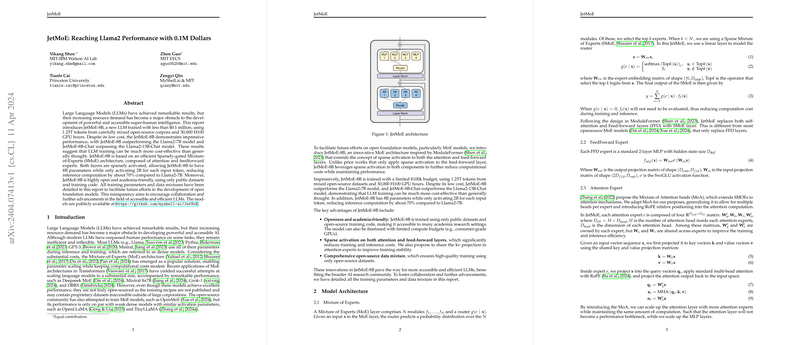Overview of JetMoE: Reaching Llama2 Performance with $0.1M
The paper "JetMoE: Reaching Llama2 Performance with 0.1M Dollars" presents a comprehensive paper on the development and evaluation of the JetMoE-8B model, a LLM trained under significant budget constraints while achieving competitive performance against well-known models such as Llama2. This paper focuses on the efficient training methodologies and architectural optimizations employed to create a cost-effective model that maintains high performance across a variety of benchmarks.
Introduction
The research addresses a critical issue in the development of LLMs: the increasing computational and financial demands required to achieve state-of-the-art performance. The JetMoE-8B model utilizes a Sparsely-gated Mixture-of-Experts (SMoE) architecture to alleviate these demands. By activating only a subset of the total parameters during training and inference, this approach reduces computational costs significantly. JetMoE-8B incorporates both sparse attention and feedforward layers, activating only 2B parameters out of 8B per input token. This greatly minimizes inference computation compared to other models like Llama2-7B, which use all their parameters simultaneously.
Model Architecture
The architecture of JetMoE-8B is designed to maximize efficiency without compromising performance. It extends the sparse activation technique to both the attention and feed-forward layers, inspired by the ModuleFormer architecture. By doing so, the model efficiently manages computational resources, activating only necessary parameters per input token.
Mixture of Experts
In the JetMoE framework, the Mixture of Experts (MoE) layer is a central feature. Each MoE layer comprises multiple experts and a router to select the top-k experts for each input. The sparse activation reduces the computational load during both training and inference phases.
FeedForward and Attention Experts
The model uses a standard 2-layer MLP for each feedforward expert while the attention experts incorporate innovations like the Mixture of Attention heads (MoA) with RoPE relative positioning. The shared key and value projection matrices across attention experts further enhance efficiency and training stability.
Pretraining and Data Mixture
JetMoE-8B is pretrained on a mixture of open-source datasets spanning web documents, code, and mathematical content. The datasets include RefinedWeb, StarCoder, The Pile, Dolma, and others. The training strategy involves two phases, with an initial phase focused on a broader data mix and a second phase emphasizing high-quality data to fine-tune the model, increasing the weight of high-quality data during the learning rate decay phase.
The training was conducted using the Megatron framework with modifications to support MoA and z-loss. The infrastructure consisted of a cluster with 96 H100 GPUs spread across 12 nodes. Hyperparameters were selected based on empirical results from prior research and set to optimize both performance and computational efficiency.
Model Alignment
JetMoE-8B-Chat is aligned through a two-step process comprising Distilled Supervised Fine-Tuning (dSFT) and Distilled Direct Preference Optimization (dDPO). dSFT involves instruction tuning with data distilled from a teacher model, while dDPO refines this by incorporating teacher model preferences into the reward function. This alignment ensures that JetMoE-8B-Chat achieves a high degree of relevance and coherence in its responses.
Evaluation
The evaluation of JetMoE-8B includes a comparison with several leading models on the OpenLLM leaderboard and other domain-specific benchmarks. JetMoE-8B consistently outperforms or matches the performance of these models despite a lower computational budget. On metrics like Hellaswag, MMLU, and TruthfulQA, JetMoE-8B excels, demonstrating the efficacy of its architecture and training regimen.
Implications and Future Work
This research underscores the potential for creating high-performance LLMs in a cost-effective manner. The adoption of the SMoE architecture proves that significant computational savings can be achieved without a considerable drop in model performance. The described methodologies and open-source nature of JetMoE-8B facilitate further research and collaboration across the AI community.
However, due to budget constraints, the paper lacks ablation experiments that could provide deeper insights into the contributions of various components. Future research could look into optimizing hyperparameters and data mixtures further, potentially improving the performance and efficiency of ensuing models.
Conclusion
JetMoE-8B exemplifies a significant stride towards democratizing access to advanced LLMs by presenting an efficient, open-source approach to training LLMs. The detailed reporting of training parameters and data mixtures provided in this paper fosters reproducibility and further advancements in the field. By balancing cost and performance effectively, JetMoE-8B paves the way for future research aimed at creating accessible and potent AI solutions.
